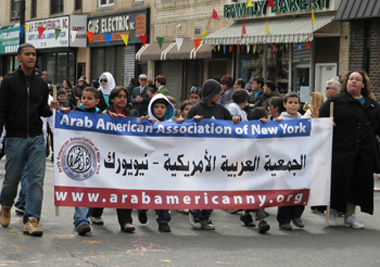Hate Crimes Against Arab and Muslim-Americans Rose Post 9-11, While Other Groups Showed Decrease, New Study Reports
UAlbany and University of South Florida researchers find two groups most at risk reside in counties where sparsely represented
Contact: Catherine Herman (518) 956-8150
 |
|
A group of Arab-Americans march in the Bay Ridge, Brooklyn, St. Patrick's Day Parade in 2010 |
ALBANY, N.Y. (February 15, 2011) --
In the weeks and months following the September 11, 2001, terrorist attacks, hate crimes against Arab and Muslim-Americans spiked. However, hate crimes against other groups decreased during this time, says a newly published article authored by University at Albany and University of South Florida (USF) researchers.
"Hate Crimes against Arabs and Muslims in Post-9/11 America," appearing in the February issue of Social Problems, reveals that, concurrent to the dramatic rise in hate crimes against Arab and Muslim-Americans in the wake of 9/11, the incidence of hate crimes against blacks, whites, Asians, and Latinos fell.
The team of sociologists, led by doctoral student Ilir Disha and associate professor Ryan King from UAlbany's Department of Sociology and associate professor James Cavendish of USF, conclude that "9/11 created a climate in which many Americans felt united against a 'new enemy' and in which acts of hatred against Arabs and Muslims became 'normalized' behaviors."
The researchers made ample use of hate-crime statistics from the FBI's Uniform Crime Report (UCR) program, and to an important but lesser degree from U.S. Census demographic variables, Arab and Muslim advocacy groups' measures, and county indicators of political affiliation obtained from Polidata.
The study also reveals that in the aftermath of 9/11 Arab and Muslim-Americans were at greatest risk of victimization in U.S. counties where their proportion of the population was very small while the proportion of the population that was white was very large. The authors argue that this is a case where "the small minority group is visible, has little protection, and is thus highly vulnerable."
The authors criticize the lack of an "Arab" category in the nation's hate-crime reporting mechanisms, which, they argue, is a major obstacle in studying hate crimes against Arab Americans in the wake of 9/11. While Muslims are covered by the racial, ethnic and religious categories established by the federal Hate Crime Statistics Act of 1990, hate crimes against Arabs are likely to be assigned to the "other ethnicity" category.



